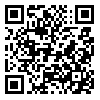BibTeX | RIS | EndNote | Medlars | ProCite | Reference Manager | RefWorks
Send citation to:
URL: http://jps.ajaums.ac.ir/article-1-55-en.html
Introduction: The current research has been done in order to compare learning styles and self-efficacy of learners of different majors; moreover, the comparison of these variables has been calculated between male and female students.
Methods and Materials: The causal comparative pattern has been used in this study. The participants of this study were medical students, MA students in engineering, art, and human science in Islamic Azad University Tehran Branch in 2008 and 2009. The sampling technique was stratified random sampling and the population included 100 male and female university students (25 students in each major). Witkin (1971) Group Embedded Figure Test (GEFT) was used to measure learning styles; in addition, Bandro self-efficacy questionnaire (1995) was used to measure self-efficacy of the learners.
Results: After data analysis, the result demonstrated that the students of engineering use more field independence learning style, but there were no significant differences among the learning styles of the students of other majors. Medical students had the highest level of selfefficacy. There were no significant differences between male and female’s learning styles and
self-efficacy.
Discussion and Conclusion: Learners, who have independent learning style, tend to study those majors that require such capabilities include engineering courses, math, and physics. Due to the persuasive factors, medical students have high self efficacy scores as well as positive attitude. Since the experience of success and mastery are the most significant factors of constructing high self-efficacy, those learners self-efficacy’s scores are more than the others. In addition, medical students increase their efficacy expectation through model making by observing those who have been in this field of study and have been successful in their academic study as well as their occupation.
Received: 2015/09/17 | Accepted: 2015/10/25 | Published: 2015/12/21
| Rights and permissions | |
 |
This work is licensed under a Creative Commons Attribution-NonCommercial 4.0 International License. |


